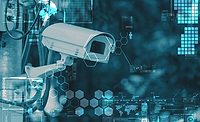Video cameras can use edge AI to create a safer environment

Image via Unsplash
Video cameras are all around. In doorbells, in elevators, throughout airports, sporting venues and city streets. The smarter these video cameras become, the more they can do, from enhancing home security and public safety to monitoring and optimizing traffic patterns.
With the rise of smarter camera systems comes a need for greater automation — the ability to monitor video streams and generate insights more quickly, while at the same time making streaming and storage more efficient and cost-effective. This is where artificial intelligence (AI) comes into play.
But even AI-supported camera systems can only do so much. That’s because traditional AI models are cloud-based and often suffer from latency issues and other challenges. They’re incapable of real-time insights and alerts; integration with the cloud poses data privacy concerns; and their dependency on networks impacts reliability.
Therefore, advanced AI for smart cameras requires a solution that doesn’t depend on the cloud. What’s needed is AI at the network edge. And if edge AI cameras are going to live up to their potential — handling many disparate, important video functions all on their own — they can’t just be capable of some AI processing. They need to be able to handle lots of AI processing.
Smart cameras need edge AI
Edge AI, in which AI processing is performed directly in cameras, offers the ability to deliver video analytics, insight and alerts in real-time for a higher level of security. Moreover, AI at the edge enables the streaming of metadata and analysis only — rather than entire video streams — thus reducing the cost of transferring, processing and storing video in the cloud. Not to mention, edge AI can enhance privacy and reduce network dependencies by keeping data out of the cloud.
However, to date, most smart cameras include limited compute power for handling AI processing. They’re also largely incapable of enhancing video on-the-fly, which is critical to accurate analytics.
What sets apart the next generation of smart camera systems is the incorporation of high compute power and AI processing capacity directly in the cameras, enabling not only the processing of advanced video analytics, but also applying AI for video enhancement to achieve high-quality video. And because each of these functions — enabling advanced video analytics and enhancing video quality — demand their own AI capacity, today’s smart cameras need to be equipped with the right amount of AI power.
Better video means better analytics
As much as it’s associated with analytics, AI can also be used in smart cameras to improve image quality and provide a clear, sharp image. In public safety situations, a high-quality video image can make all the difference when assessing risk.
Low-light conditions, for example, can limit viewing distance and reduce image quality. The resulting video “noise” makes it hard to differentiate detail while actually increasing data size during compression. This leads to poor system efficiency when transmitting and storing video data in the cloud.
And as higher resolution video streams become more common in smart camera systems, the need arises to process a greater amount of data, to detect and identify more complex and granular objects and to execute more tasks via complex AI processing pipelines.
How much AI processing is enough?
When a camera has enough AI capacity, it can run advanced video analytics on top of AI-powered video enhancement. It can even run multiple AI processes on the same video stream, identifying smaller and more distant objects with higher accuracy, for example, or performing faster detection at higher resolution. In traffic applications, a smart camera with sufficient AI processing can perform multi-step automatic license plate recognition, which requires object detection to identify every car on the road plus license plate detection to find the license plate on every car plus license plate recognition to determine the characters in each license plate.
But again, for accurate analytics on high-quality video imagery, smart cameras themselves need enough AI power to run both video enhancement and analytic tasks in parallel. For example, in order to get an accurate license plate number in a stream, the camera’s vision processor needs to apply semantic awareness (understanding what it sees) in order to selectively clean up and sharpen the parts of the video that contain relevant visual information. In such cases, processing demands add up quickly.
Ultimately, integration of AI into smart cameras will revolutionize many different industries, including security, industrial automation, retail and more. A paradigm shift in the way security leaders capture, process and interpret visual information requires pushing the AI revolution out to the edge of networks, where it can do the most good — and quickly. Taken separately, AI and video have already had a profound impact. Together, they can reshape everyday life for the better.
Looking for a reprint of this article?
From high-res PDFs to custom plaques, order your copy today!








